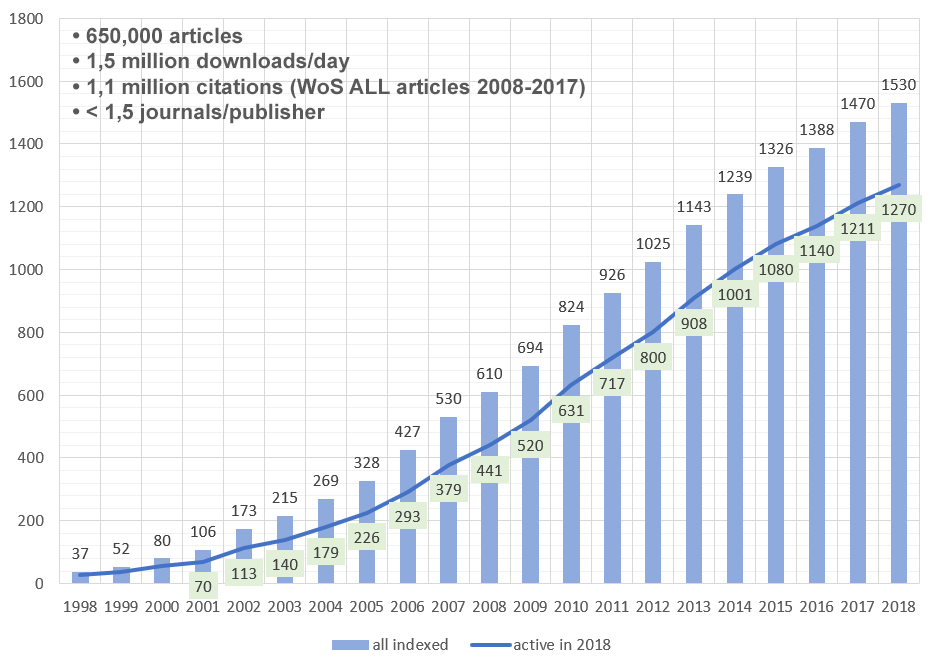By Abel L Packer and Solange Santos1
Open access to articles

One of the familiar Open Science practices is Open Access to the texts of articles made publicly available on the web, either by journals in the modality known as Golden Open Access or by the authors themselves on their own websites, institutional or thematic repositories, right after publishing the article or after an embargo period of six to twelve months imposed by the journal, known as Green Open Access. The main self-financing or commercialization model used by golden open access journals is charging the authors with a publication fee, internationally known as Article Processing Charge (APC). Most subscription journals also publish part of the articles in open access through an APC, a mode called hybrid. APC’s most frequent values range from US$ 1500 to US$ 5000.
Pioneered for more than 20 years in Brazil by SciELO and in subsequent years by 13 other countries (Figure 1), and consolidated globally as a scholarly communication mode, Open Access signals the viability of other Open Science practices, but not without challenges. Its widespread adoption still faces strong resistance from commercial publishers seeking a business model that has a financial return equal to or greater than that of subscription-restricted journals.

Figure 1. SciELO Network – evolution of the number of indexed and active journals by 14 certified national collections between 1997 and 2018.
However, the challenges facing Open Access universalization include the entire scientific system. The validation of articles describing the research is carried out by journals with the collaboration of expert (peer) researchers. However, this qualification of the evaluation in different areas is associated with the prestige or impact of the journals, almost always measured by annual bibliometric citation indicators per article. Thus, despite widespread criticism, journals and their rankings act as a proxy for the quality of the research they publish, and their prestige or impact is extended to the research authors, their graduate programs, departments, universities, countries, and regions of the world. As most of journals best ranked by bibliometric indicators are marketed by publishers, those endure a great power among research communities to resist the advancement of open access and, thus, Open Science.
Celerity and transparency in research communication – heading toward preprints
Incorporated as a flag of the Open Science movement, journals are increasingly challenged by the delay and lack of transparency of the manuscript evaluation process, often referred to as the “black box”, without explicit bias safeguards pro or against authors for attitudes and decisions influenced by their geographical origin, nationality, ethnicity, gender, age, schools of thought, etc. The main pathway is openness that includes continuous publication, adoption of preprints, and open peer review as the most advanced stage.
In classic online publishing, many journals minimize the processing time by publishing manuscripts shortly after approval in a provisional version, without editing, or use the so-called continuous publication of individual articles, soon after being approved and edited, with an identification number which replaces pagination. Continuous publication has been around for about 20 years, but has become popular with mega journals that operate as an article platform, as in the case of PLOS ONE and Scientific Reports. SciELO strongly recommends that all journals adopt continuous publication.
However, the delay in publishing research results articles is completely resolved by initiating the communication flow with manuscripts made available as preprints in open access, before or in parallel with journal submission. Besides speeding up the communication of research results, preprints, as formally preserved documents provided with a Digital Object Identifier (DOI), ensure authors precedence over discoveries, new ideas and processes, and allow manuscripts to be improved before or during the assessment process by a journal by allowing the generation of successive enhanced versions from comments and suggestions received on the preprint server. They may also be cited and registered in the researchers’ curriculum to inform grant applications and reports. Once accepted by a journal, the preprint is updated with an approval note and a link to the published article. There is also a growing exposure of articles already published to public comment, which is characterized as a post-publication assessment.
SciELO and the Public Knowledge Project (PKP), responsible for Open Journal Systems (OJS), established in 2018 a partnership for the development of a system which foresees the implementation of a preprint server. The goal is to include all thematic areas, with the perspective of strengthening the article flow of journals it indexes with better quality manuscripts, without delays in research communication. Internationally, there are several well-established preprint servers such as arXiv, which was created in 1991 and currently covers physics, math, computer science, and six other areas; bioRxiv and PeerJ, created in 2013 for the life sciences areas; SSRN, created in 1994 for Social Sciences, Humanities and other disciplines; and OSF Preprints, which operates a collection of more than 20 preprint servers, etc.
Regarding the transparency of peer review, a still small but growing number of journals offer options of progressive openness to editors, authors and reviewers. SciELO recommends the following options for gradual transparency and openness advancement: including of the name of the editor responsible for assessment and approval in the published article; publication of the reviews of articles approved as scholarly communication texts with a DOI; and disclosing the identities of the authors and reviewers during the evaluation process. However, Brazil’s journals are still reluctant in adopting full openness of manuscript evaluation as the F1000 Research publishing platform.
Lines of Action for the forthcoming years
All research actors and instances are called to position themselves politically and operationally in the face of the challenges and, especially, the advantages and gains that the adoption of Open Science mean for their respective areas, as well as their interdependencies, in which participation and cooperation play a decisive role. The refusal to stand up to the complexities and wait for what’s to come may be comfortable at first, but it can also reduce gains, move away from the state of the art, and slow down the Open Science practices learning curve.
The most internationalized thematic areas are conditioned by the pace of adoption of Open Science, dictated by the science and technology organizations, scientific societies and commercial publishers from developed countries. The less internationalized ones should dictate their own pace, which opens a field of adjustments and innovations of research structures. However, for both contexts, the proactive positioning of authorities, research and institutional public policies is essential to advancing on learning and to advocate national interest agendas.
Researchers, while responsible for the formulation and execution of research projects, are at the same time the most important actors and those that most depend on other actors and instances in the process of adopting Open Science, especially the journals leadership, which increasingly lead researchers to meet Open Science practice requirements in their editorial policies and procedures. Researchers’ proactivity will also depend on funding policies and research evaluation systems in the event that they start requiring or rewarding compliance with Open Science practices.
University and institutional library systems have been playing a leading role in the adoption of Open Science practices, especially in their dissemination of the operation of research data repositories.
In the course of adopting Open Science, it is worth remembering, first of all, that the appropriation of the innovations it brings conforms a politically, socially, financially, and operationally complex process, which will require months of learning and years of experience, with successive adjustments until it becomes the predominant research modus operandi. Then, it is worth remembering that this is a global venture that will progressively embrace all countries, disciplines and thematic areas, but whose development embodies countless contexts. In this sense, the greatest challenge for the Brazilian research communities and authorities is to define and implement lines of action to timely position the country in the national and global advancement of Open Science, focusing on strengthening and expanding capacities and infrastructures suitable to the conditions and priorities of each environment.
Among the first lines of action stands out, on the one hand, the promotion in different communities of a broader understanding of what is Open Science to its full extent, how it will impact each and every one, and especially how it has enriched the scientific capacity and priorities of each context. On the other hand, promoting dialogues for the formulation of public positions of research communities in alignment with Open Science practices. Understanding and the progressive building of consensus in favor of Open Science best practices in different contexts is a condition and means for overcoming resistance and proactive positioning.

Note
1. This post was originally published in Boletim Informativo da Sociedade Brasileira de Ciência do Solo and split into two parts for publication in the SciELO in Perspective blog. See Part I here.
References
ALBAGLI, S., MACIEL, M.L. and ABDO, A.H. (org.). Ciência Aberta, questões abertas. Brasília: Ibict; Rio de Janeiro: Unirio, 2015 [viewed 1 August 2019]. Available from: https://bit.ly/2o2b6c4
BENEDIKT, F. and SASCHA, F. Open Science: One Term, Five Schools of Thought. In: BENEDIKT, F. and SASCHA, F. (eds) Opening Science. Cham: Springer, 2014 [viewed 1 August 2019]. DOI: https://doi.org/10.1007/978-3-319-00026-8_2
MONS, B. Data Stewardship for Open Science: Implementing FAIR Principles. Boca Raton: CRC Press, 2018. Available from: https://bit.ly/2uVb47z
PACKER, A.L. and SANTOS, S. Ciência Aberta e o novo modus operandi de comunicar pesquisa. Boletim Informativo da Sociedade Brasileira de Ciência do Solo. 2019, vol. 45, no. 1, pp. 17-24 [viewed 1 August 2019]. Available from: https://www.sbcs.org.br/wp-content/uploads/2019/06/Boletim-SBCS-Volume-45-N%C3%BAmero-1.pdf
SANTOS, P.X., et al. Livro Verde – Ciência Aberta e dados abertos: mapeamento e análise de políticas, infraestruturas e estratégias em perspectiva nacional e internacional. Rio de Janeiro: Fiocruz, 2017 [viewed 1 August 2019]. Available from: https://www.arca.fiocruz.br/handle/icict/24117
SciELO – Linhas prioritárias de ação 2019-2023 [online]. SciELO 20 Anos. 2018 [viewed 1 August 2019]. Available from: https://www.scielo20.org/redescielo/wp-content/uploads/sites/2/2018/09/Líneas-prioritaris-de-acción-2019-2023_pt.pdf
WILKINSON, M. D., et al. The FAIR guiding principles for scientific data management and stewardship. Scientific Data [online]. 2016, vol. 1, no. 3 [viewed 1 August 2019]. DOI: 10.1038/sdata.2016.18. Available from: https://www.nature.com/articles/sdata201618
External links
O que é Ciência Aberta? – Formação Modular em Ciência Aberta <https://campusvirtual.fiocruz.br/gestordecursos/mod_hotsite/ciencia-aberta>
Open Science MOOC <https://opensciencemooc.eu/about/>
Research Data Alliance <https://rd-alliance.org/>
The FOSTER Portal <https://www.fosteropenscience.eu/>
Translated from the original in Portuguese by Lilian Nassi-Calò.
Como citar este post [ISO 690/2010]:

















Recent Comments